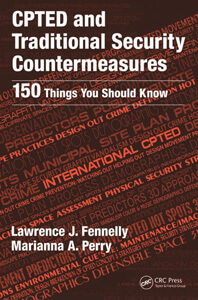Book Review: CPTED and Traditional Security Countermeasures
CPTED and Traditional Security Countermeasures: 150 Things You Should Know. By Lawrence Fennelly and Marianna Perry, CPP. Routledge; available from asisonline.org; 462 pages; $75 (members), $80 (nonmembers).
 This latest publication by the writing team of Lawrence Fennelly and Marianna Perry, CPP, focuses on crime prevention through environmental design (CPTED) and other tried-and-true security measures. Like many of their books, CPTED and Traditional Security Countermeasures: 150 Things You Should Know consists of 150 chapters that are typically only two or three pages long. The chapters contain lists or bullet points on topics ranging from CPTED in schools, hospitals, and country clubs to community policing, mental health, and emerging issues.
This latest publication by the writing team of Lawrence Fennelly and Marianna Perry, CPP, focuses on crime prevention through environmental design (CPTED) and other tried-and-true security measures. Like many of their books, CPTED and Traditional Security Countermeasures: 150 Things You Should Know consists of 150 chapters that are typically only two or three pages long. The chapters contain lists or bullet points on topics ranging from CPTED in schools, hospitals, and country clubs to community policing, mental health, and emerging issues.
The book explains the first, second, and third generations of CPTED theory, using examples and case studies from around the world, including management strategies in France and Italy, bicycle paths in Australia, and defensible space in Canada. Information is backed up by recent studies, with footnotes for easy reference. Some chapters venture into practical considerations and different viewpoints, such as shopping safety tips and CPTED from a fire department perspective.
There are two appendices in the book: Appendix A provides a brief review of the fear of crime while Appendix B offers two excellent charts: the concepts of each CPTED generation and the components of an effective security program.
This book should be included in the library of anyone working in security, law enforcement, facility management, or building design. It provides concise information on such a wide range of security issues that it can be read cover to cover or kept as a reference to research individual challenges as they emerge.
Reviewer: Adam Parsons, CPP, is a supervisor of security and life safety with GWL Realty Advisors in Calgary, Alberta, Canada. He has worked in physical security and law enforcement for 22 years, for amusement parks, government buildings, and a university campus.
